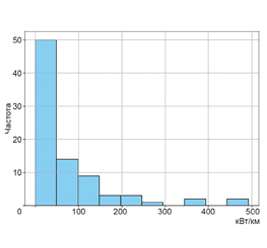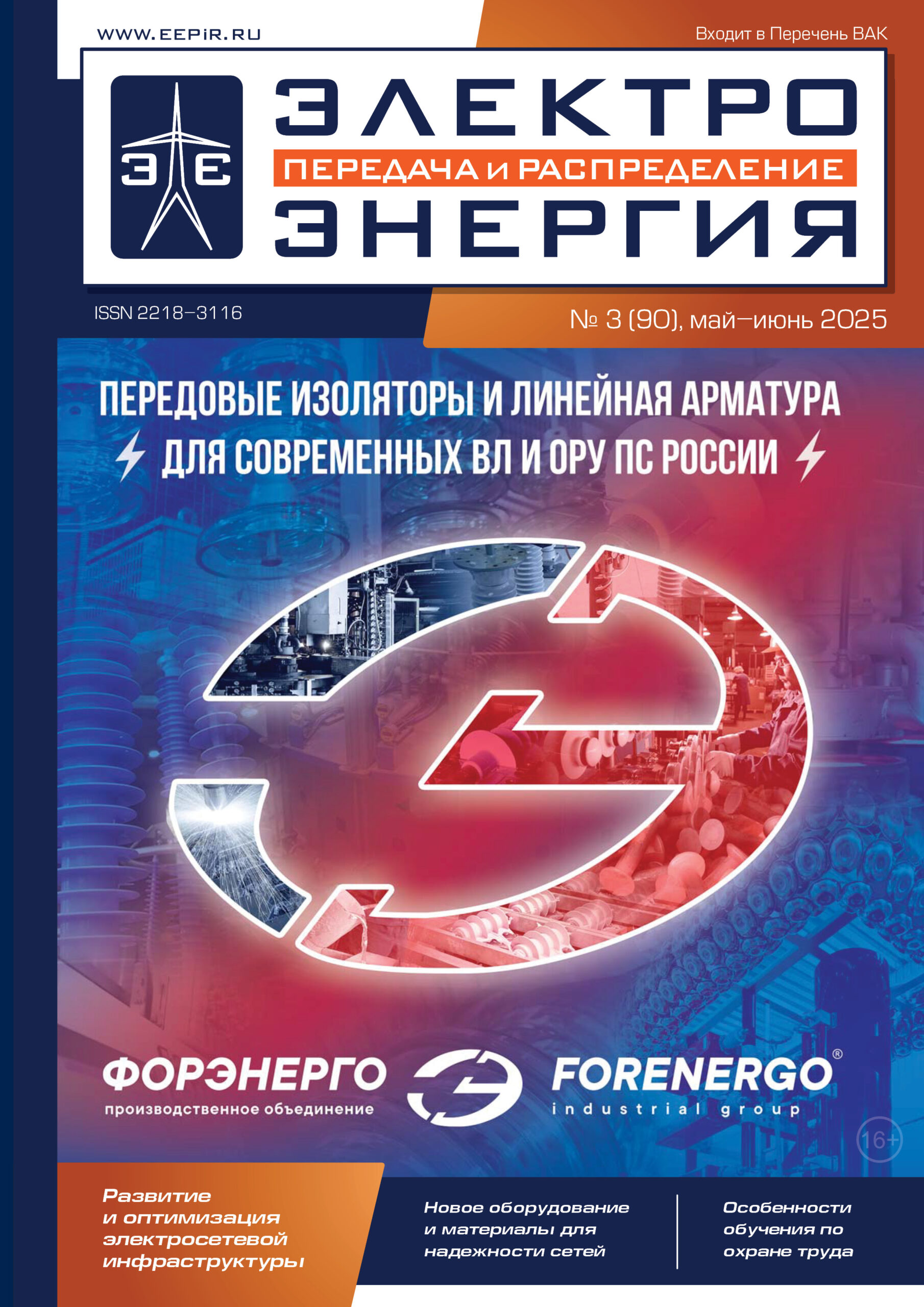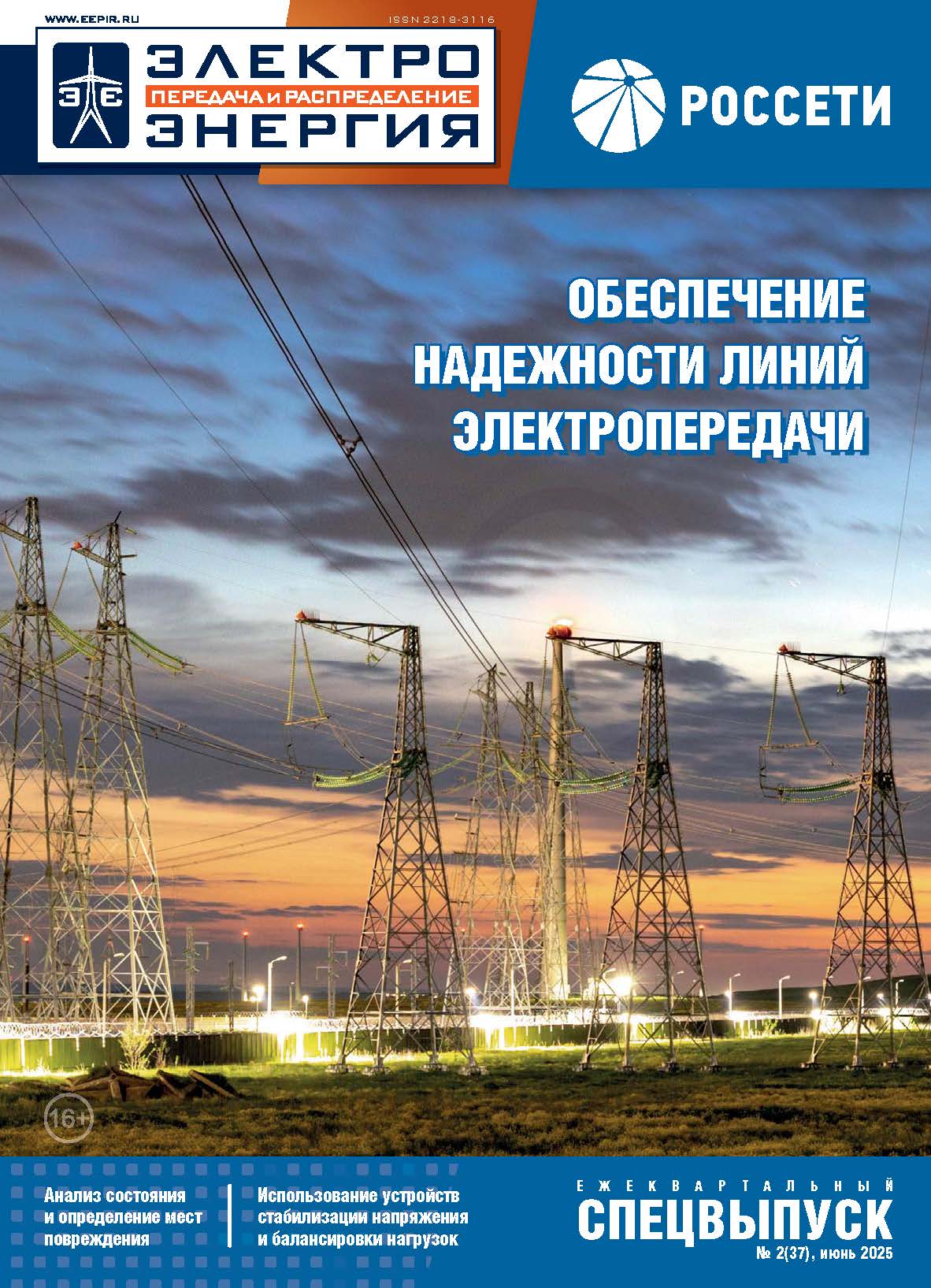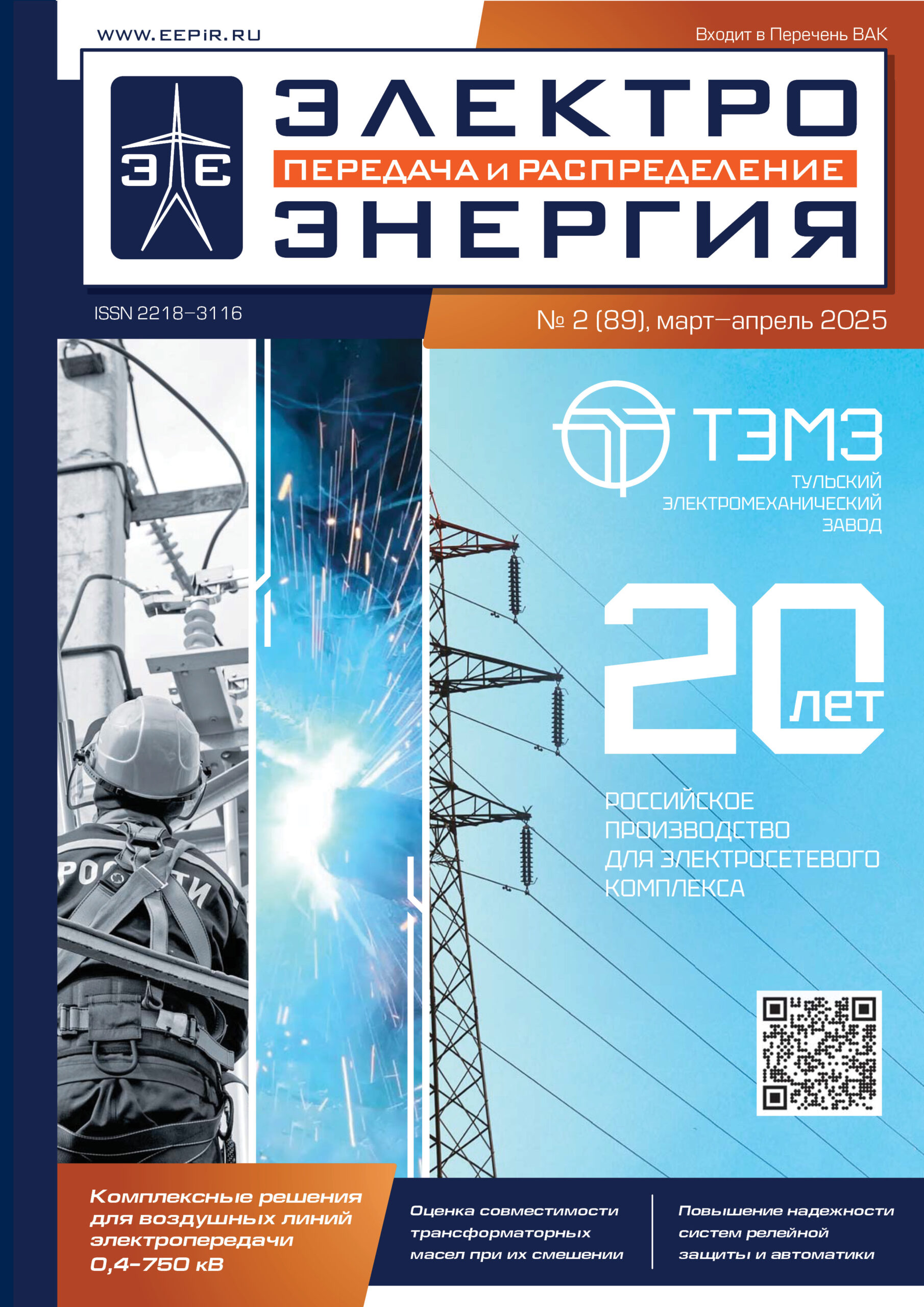
The MAIN JOURNAL for POWER GRID SPECIALISTS in RUSSIA
2014

DIGEST, February, 2014
26
Network management
Innovation Suite of IT-Systems to
Control Power Supply of Olympic
Venues in Sochi
Andrey BADALOV (Андрей БАДАЛОВ), First Deputy General Director,
Dmitry GVOZDEV (Дмитрий Гвоздев), Deputy General Director, Cand. of Technical Sciences,
Boris SHVEDIN (Борис ШВЕДИН), Chief Ontologist, Cand. of Psychological Sciences, CJSC “RTEC”,
Leonid BUZAEV (Леонид БУЗАЕВ), Deputy Chief Engineer, JSC “FGC UES”
T
he
fi
rst-of-its-kind suite of IT-systems designed to
control power supply in Sochi was commissioned
in September of 2013. Information systems of the
Power Supply Control Centre (PSCC) of Sochi
energy region were designed according to the special order
of JSC “FGC UES”, part of JSC “Russian Grids” Group
of Companies. The project was implemented within the
framework of an agreement on interaction signed between
JSC “FGC UES” and Rostec Corporation. The direct pro-
ject contractor was CJSC “RTEC”, part of Rostec Corpo-
ration. The large-scale high-tech project was implemented
within a short time. The period from development of tech-
nical solutions to commissioning of the system at PSCC of
Sochi energy region was less than half a year.
The main task of PSCC is monitoring and analyzing
the general and operational situations at power facilities
involved in external power supply of Olympic venues and
infrastructure facilities in Sochi, as well as organization
of interaction and coordination of efforts of all entities.
PSCC is to ensure ef
fi
ciency and justi
fi
cation of the taken
decisions through introduction of innovative technologies,
analysis and visualization of information that is critical for
situational control of operation both in normal operating
and emergency modes.
PSCC implements a suite of three integrated basic in-
formation systems, which includes the Decision Support
System (DSS), the main and redundant SCADA Systems.
The main tasks of PSCC suite of information systems
are the following:
• monitoring of general and operational situations. Reg-
ular preparation and reporting of monitoring results in
accordance with provisions of the Regulation on the
control of power supply of Olympic venues and prin-
ciples of interaction between organizations supplying
power to Olympic venues during preparation for and
holding XXII Olympic Winter Games and XI Paralym-
pic Winter Games 2014 in Sochi;
• real-time situational analysis and assessment for facili-
ties supplying power to Olympic venues in Sochi re-
gion;
• coordination of actions of organizations operating
Olympic venues in case of accidents and emergency
situations in external power supply networks of these
venues;
• interaction with regional and federal authorities, struc-
tural subdivisions of EMERCOM of Russia, personnel
of grid companies and companies providing back-up
power supply of Olympic venues.
The PSCC decision support system is designed for con-
stant comprehensive and real-time situational monitoring
and, ultimately, for increasing ef
fi
ciency and justi
fi
cation
of decisions. DSS is designed for creating conditions for
individual and joint work of operating personnel of sub-
stations,
fi
eld crews and PSCC personnel both in normal
operating mode and in emergency situations.
PSCC DSS is based on QuaSy-DSS platform; its meth-
odological basis is formed by innovative smart technolo-
gies, including methods of ontological modelling, the
concept of systemic situational analysis of activity, expe-
rientology as the direction providing for structuring, or-
ganizing, accumulating and translating of experience, as
well as the language of structured messages. This was the
actual foundation for automation of processes of collec-
tion, processing, statistical analysis and visual display of
information about current activities of organizations sup-
plying power to Olympic venues, including maintaining
electronic operating documentation by PSCC personnel.
PSCC DSS provides for ful
fi
llment of the following
functions:
• receiving, storing, displaying and preliminary analy-
sis of regular data
fl
ows in-coming as structured mes-
sages (basic real-time information) from workplaces
of PSCC on-duty operating personnel generated on the
basis of the power engineer’s language of structured
messages;
• receiving, conversion, analysis of regular
fl
ows of
well-structured messages, their classi
fi
cation and
submission of operational situation reports to various
levels of decision-taking in order to create a coherent
view of the objectively existing situation;

www.eepr.ru
27
CJSC "Russian Telecom Equipment Company” (RTEC)
is the Russian
private-public company established in 2007 by a resolution of the Government of
the Russian Federation as a joint enterprise of Rostec State Corporation and a group
of high-tech IT-companies with the aim of designing and manufacturing in Russia of
trusted telecommunication equipment and communications systems. RTEC is a part
of JSC “Ruselectronics” Holding.
JSC “Ruselectronics”
is a group of enterprises specializing in designing and
manufacturing of electronic equipment, electronic components, electronic materials
and equipment for their manufacture, as well as microwave and semiconductor
devices. The holding company was founded at the beginning of 2009 on the basis of
the same-name state holding operating since 1997.
• maintaining and actualizing of the database of pow-
er facilities (substations and transmission lines) in
accordance with the coordinated information pro-
fi
le of equipment with the respective list of attribu-
tes;
• maintaining a database of subjects of activity on the
basis of a task-oriented classi
fi
er of subjects of activ-
ity in order to facilitate decision-taking and organizing
activities of DSS users;
• maintaining, storing, developing and direct practical
use of databases of terms, syntactic rules, typical word
combinations and autosyntax rules for maintaining
PSCC operations logs;
• visualization and structured description of electric cir-
cuit diagrams of substations and transmission lines;
• design, development and visualization of models of
organization of the enterprise’s activities and decision-
taking with possibility of their further conversion into
database objects;
• organization of PSCC personnel’s activities through
automation of the PSCC operations log maintenance
process;
• displaying of geoinformation data through interaction
with the regional GIS-node installed in PSCC;
• maintaining a database for emergency backup equip-
ment in Sochi region;
• monitoring of movements of emergency and repair
crews with the use of mobile systems and real-time
map display;
• monitoring of operating vehicles with the use of mo-
bile systems and real-time map display;
• integration of all three systems, exchange of informa-
tion related to emergency situations and unplanned
outages irrespective of its nature.
The DSS system includes 12 subsystems (modules).
1. QuaSy DSS: Message server — Message server sub-
system.
2. QuaSy DSS: Monitoring — Situational monitoring
subsystem.
3. QuaSy DSS: Objects — Subsystem of registering and
maintaining of electric power facilities (objects of ac-
tivity).
4. QuaSy DSS: Subjects — Subsystem of registering and
maintaining of entities (subjects of activity).
5. QuaSy DSS: PLSM — Subsystem of support of the
power engineer’s language of structured messages.
6. QuaSy DSS: ConFrame-Electric — Subsystem of
development, visualization and actualization of elec-
tric circuit diagrams related to the database of electric
power facilities.
7. QuaSy DSS: ConFrame-BI - Subsystem of develop-
ment, visualization of models of the enterprise’s activ-
ity organization by tasks.
8. QuaSy DSS: NCS OL — Subsystem of maintaining
operations logs of the network control center:
• QuaSy DSS: OL — NCS (for PSCC);
• QuaSy DSS: OL — NCS (for MSAC — mobile situ-
ational analysis center);
• QuaSy DSS: OL — NCS (for ODS — operating and
dispatching services);
• QuaSy DSS: OL — NCS (for DN — distribution net-
works);
• QuaSy DSS: OL — NCS (for MPC — main power
consumers).
9. QuaSy DSS: SS OL — Subsystem of maintaining sub-
station operations logs.
10. QuaSy DSS: FC OL — Subsystem of maintaining op-
erations logs of
fi
eld crews.
11. QuaSy DSS: PMIT (power engineer’s mobile individ-
ual terminal) — Subsystem of organizing data commu-
nication (structured messages) by means of personal
communication devices of substation operating per-
sonnel.
12. QuaSy DSS: PSIT (power engineer’s stationary indi-
vidual terminal) — Subsystem of organizing data com-
munication (structured messages) by means of station-
ary automated workstations of the operating personnel.
MESSAGE SERVER
Designed for collecting, storing, displaying and pre-
liminary analysis of regular data
fl
ows in-coming as struc-
tured messages (basic real-time information) from mobile
and stationary automated workplaces of operating and
dispatch personnel generated on the basis of the power
engineer’s language of structured messages.
The
fl
ow of structured messages is organized on the
basis of the power engineer’s language of structured mes-
sages (PLSM), which is a speci
fi
c instance of the Lan-
guage for Organizing Com-
mon Activity LOCA. It should
be emphasized that an integral
part of PLSM is strict use of
dispatchers’ names of facili-
ties and equipment, which are
correspondingly stored in the
integrated database. Struc-
tured messages are generated
by operation, maintenance
and administrative person-
nel by means of operations
logs (OL). They can also use
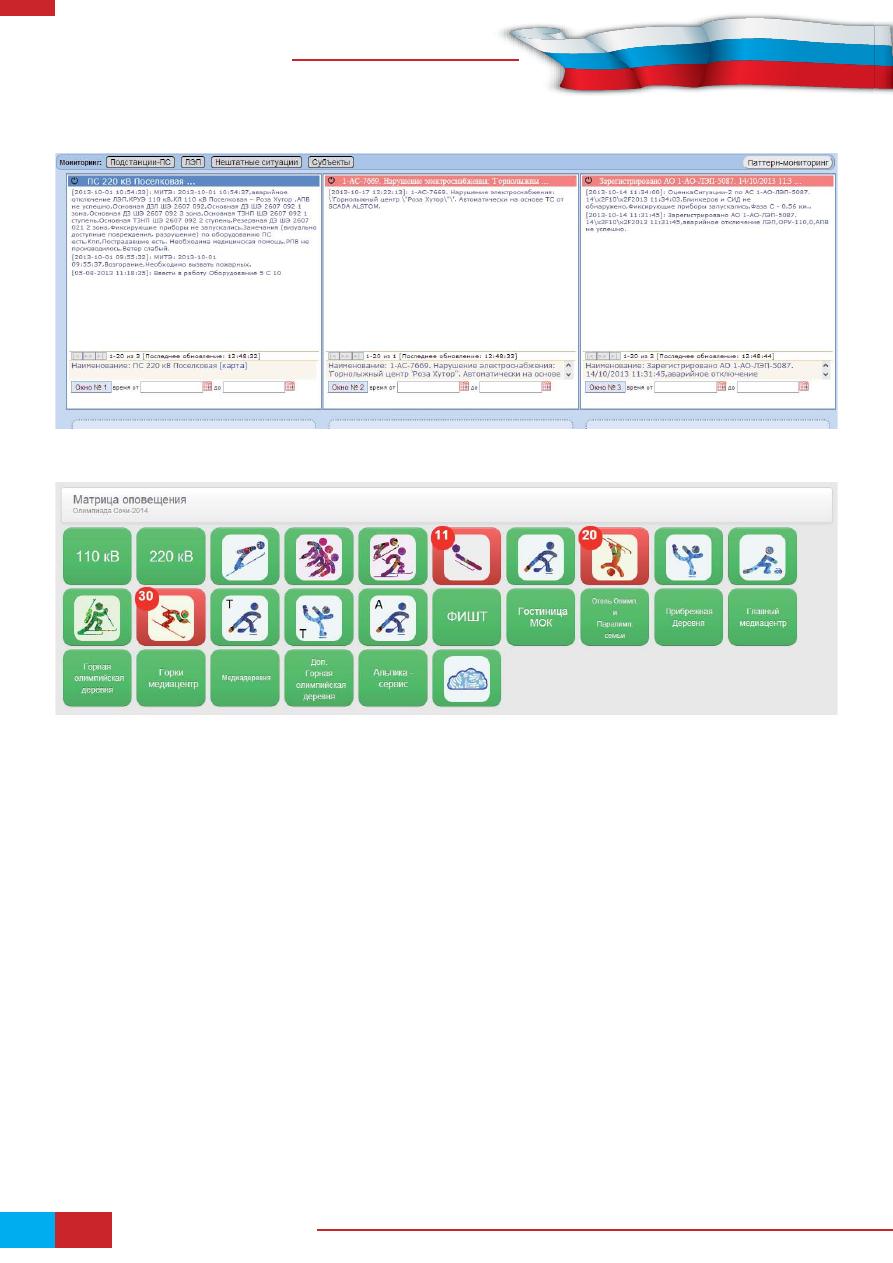
DIGEST, February, 2014
28
Network management
Fig. 1. Multi-window interface for monitoring PCSS messages
Fig. 2. Iconographic matrix of management notification
power engineer’s stationary individual terminal (PSIT)
and power engineer’s mobile individual terminal (PMIT),
the operating personnel of substations, network control
centres, operating dispatch groups and
fi
eld crews are
equipped with. OL, PSIT and PMIT are organized into a
network structure which can be controlled by transform-
ing it, when required, into a hierarchically organized sys-
tem of sources of
fl
ow structured information.
The situational monitoring subsystem provides collect-
ing, converting, analyzing and visualizing of regular
fl
ows
of well-structured messages in-coming from the message
server subsystem, their classi
fi
cation and submitting op-
erational situation reports to various levels of decision-
taking in order to have a full view of the objectively exist-
ing situation. Examples of graphic interfaces are shown in
Fig. 1—2.
The subsystem of registering and maintenance of
power facilities (objects of activity) is designed for main-
taining and actualizing of the database of power facilities
(substations and transmission lines) in accordance with
the coordinated information pro
fi
le of equipment with the
respective list of attributes.
The subsystem of registering and maintaining subjects
of activity is designed for maintaining a database of sub-
jects of activity on the basis of a task-oriented classi
fi
er of
subjects of activity. Used for decision-taking and organ-
izing activities of DSS users.
The subsystem of maintaining the power engineer’s
language of structured messages (PLSM) is designed for
maintaining, storing, developing and direct practical use
of databases of terms, syntactic rules, typical word com-
binations and autosyntax rules during automation of pro-
cesses of organization and communication of messages
from communication devices and stationary automated
workstations of the operating personnel, as well as for
maintaining operations logs of substations,
fi
eld crews
and the joint operations log of the Substations Group Con-
trol Centre.
CONFRAME-ELECTRIC
The tool for visualization and actualization of electric
circuit diagrams related to the database of electric power
facilities.
It is a graphic modeling tool for designing electric cir-
cuit diagrams of electric energy systems. Provides visu-
alization and structured description of single-line elec-
tric circuit diagrams of substations. Enables creating and
maintaining databases of electric circuit diagrams, dis-

www.eepr.ru
29
Fig. 3. Electric circuit diagram of “Kudepsta” Substation 110 kV
tribution devices, connections, elements of their compo-
nents, including description of required attributes, as well
as correlating electric circuit diagrams and their elements
with corresponding objects of databases displaying their
structured description. A Web-oriented tool making it pos-
sible both to conduct its integration into any Web-appli-
cation and use it as a separate stand-alone application. An
example of the interface is shown in Fig. 3.
CONFRAME-BI
A graphic modeling tool for designing, developing and
visualization of models of organization of the enterprise’s
activity and decision-taking by decision-makers, with a
possibility of their further conversion into objects of data-
bases. Includes tools for creating classi
fi
ers, taxonomies,
mereotopologic task trees and describing activity organi-
zation models. Implemented for visualization and struc-
tured description of models of enterprises’ activity and
decision-taking by means of ConFrame tools. Enables de-
veloping classi
fi
ers, taxonomies for subjects (entities) and
objects of business activity, building mereotopologic task
trees, structuring business activity relations, correlating
them with corresponding databases. Provides a possibil-
ity of creating and visualizing models of organization of
the enterprise’s activity by tasks, designing and describing
well-structured models of infrastructure space and timing.
A Web-oriented tool making it possible both to conduct its
integration into any Web-application and use it as a sepa-
rate stand-alone application.
OL
A subsystem of maintaining operations logs of the net-
work control centre. The principle of using OL is described
in detail in the joint work by A. Badalov, D. Gvozdev,
V. Pelymsky, B. Shvedin.
PMIT enables arranging data communication (struc-
tured messages) by means of communication devices (tab-
lets) of the operating personnel of substations. Provides
a possibility of generating and communicating messages
with the use of information pro
fi
les of equipment of cer-
tain substations or transmission lines.
Messages are generated in the dialogue mode with the
use of autosyntax in accordance with the speci
fi
ed algo-
rithm.
The substation operating personnel was offered a dia-
logue-based model of situational analysis (DMSA), which
made it possible to signi
fi
cantly reduce personnel’s mis-
takes in stress conditions. An example of the interface is
shown in Fig. 4.
CAPABILITIES AND TECHNOLOGIES OF GIS-BASED
VISUALIZATION
DSS makes it possible to work with geoinformation
data. Data of external GIS-systems can be imported into
DSS GIS-system. All data are consolidated and by means
of integration services are sent to adjacent SCADA-sys-
tems. In addition, integration services enable real-time
displaying of data, reports, diagrams from DSS of the
Joint Situational Analysis Centre on a geographic map.
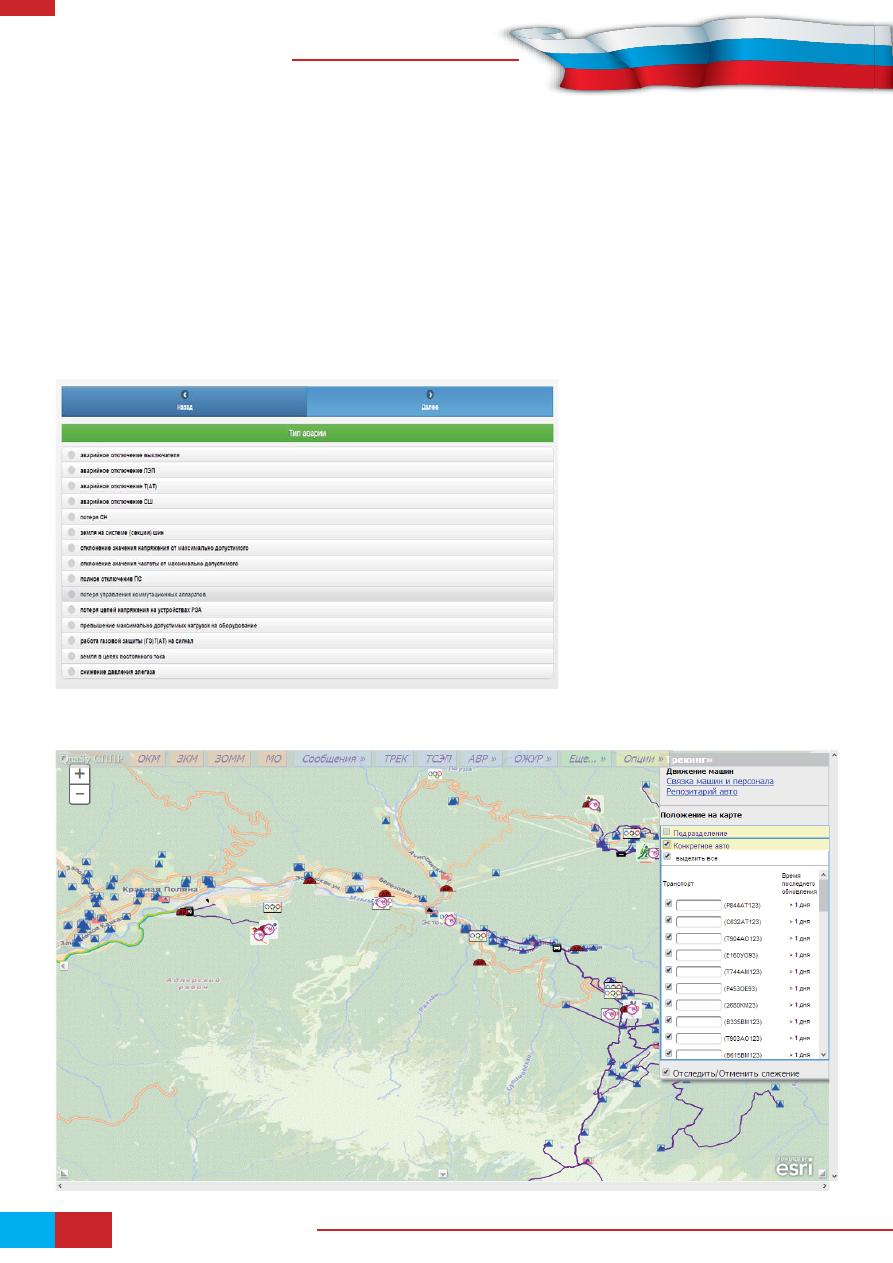
DIGEST, February, 2014
30
Network management
Fig. 5. Fragment of PCSS basic interface map. Tracking operating vehicles
Also, the GIS-subsystem receives information about
the location of operating vehicles and crews. DSS in-
terface enables easily navigating the map with all avail-
able objects to be supervised within the framework of the
PSCC IS project. A fragment of basic DSS interface with
the GIS-underlay is shown in Fig. 5.
During implementation of the project they used the
logic of displaying monitoring areas according to their
signi
fi
cance for the power supply of the region. In order to
provide full visualization of monitoring areas and depend-
Fig. 4. Dialogue-based model of situational analysis (DMSA) for on-duty
personnel of “Laura” Substation 110 kV. Selection of emergency type
ing on the level of signi
fi
cance each of the areas is high-
lighted on the map with a certain color (the traf
fi
c lights
rule). Green color means ‘less signi
fi
cant’, yellow — ‘sig-
ni
fi
cant’ and red — ‘most signi
fi
cant’ (Fig. 6).
The main SCADA provides monitoring and displaying
diagrams and operation pattern of Sochi energy region of
Kuban energy system as well as condition of the equip-
ment (main SCADA-1). For the
fi
rst time in the Russian
electric power industry they commissioned the SCADA-
EMS e-terraplatform system by Alstom.
It should be emphasized that
SCADA-EMS, built on the basis of
the equipment database following IEC
(CIM) standards, was integrated for the
fi
rst time in the Russian electric power
industry, too.
The
fl
ow of the manipulated telem-
etry is strictly attached to the equipment
database and supported by it.
Special attention should be paid to
the e-terravision technology (SA - situ-
ational awareness). It is the
fi
rst-time
integration of the given solution, which
is innovative for the world practice, in
Russia.
The redundant SCADA Syndis was
supplied by “Mikronika” Company.
The virtual concentrator (central receiv-
er-transmitter station), an innovative
tool enabling programmatically organ-
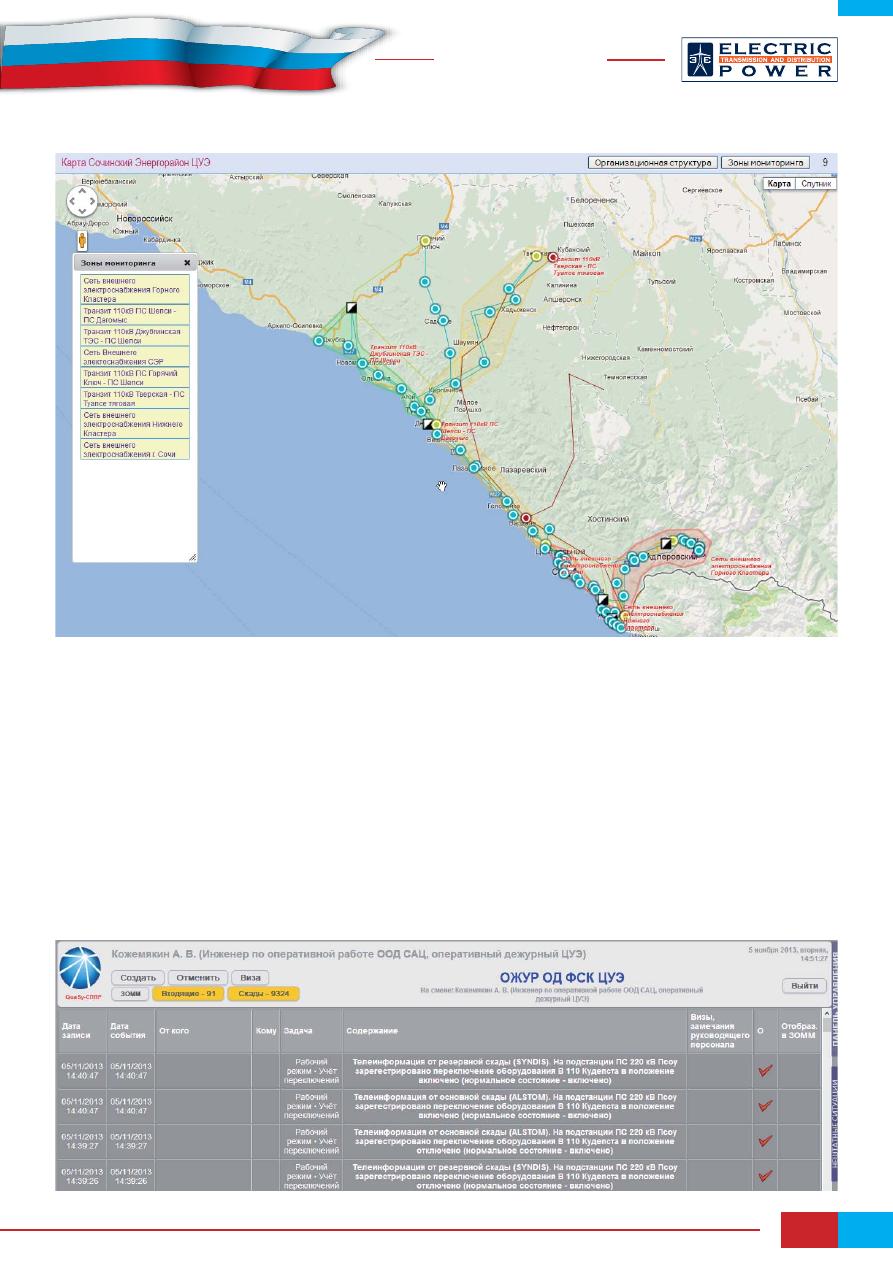
www.eepr.ru
31
Fig. 7. PCSS on-duty engineer’s OL Interface. Integration of DSS, SCADA Alstom and SCADA Syndis
Fig. 6. Interface for monitoring areas
izing the telemetry
fl
ow, was used for the
fi
rst time. Also,
integration of the redundant SCADA and DSS was carried
out. The redundant system provides monitoring and dis-
playing diagrams and operation pattern of Sochi energy
region of Kuban energy system as well as condition of the
equipment.
For the
fi
rst time the PCSS project implemented the
technology of semantic integration between SCADA-
EMS e-terraplatform and QuaSy DSS by using the
QuaSy ConFrame-Electric Federator tool. The seman-
tic integration was carried out with the use of the se-
mantic ID generator for all equipment, as well as for
the full telemetry
fl
ow. Thus, each telesignal and telem-
etering had not only its address, but also its semantic
ID.
For the purpose of integration with SCADA Syndis
only internal IDs of the system itself were used. In case of
manual control of switching equipment the respective sig-
nals were sent from DSS to the main and redundant SCA-
DA systems, like from a single source. On the other side,
telesignals generated in the main and redundant SCADA
systems were received by DSS for analysis.
Fig. 7 shows the PCSS on-duty engineer’s working
interface, which clearly demonstrates the way teleinfor-
mation is received from SCADA Alstom and SCADA
Syndis.
Оригинал статьи: Innovation Suite of IT-Systems to Control Power Supply of Olympic Venues in Sochi
The first-of-its-kind suite of IT-systems designed to control power supply in Sochi was commissioned in September of 2013. Information systems of the Power Supply Control Centre (PSCC) of Sochi energy region were designed according to the special order of JSC “FGC UES”, part of JSC “Russian Grids” Group of Companies.




